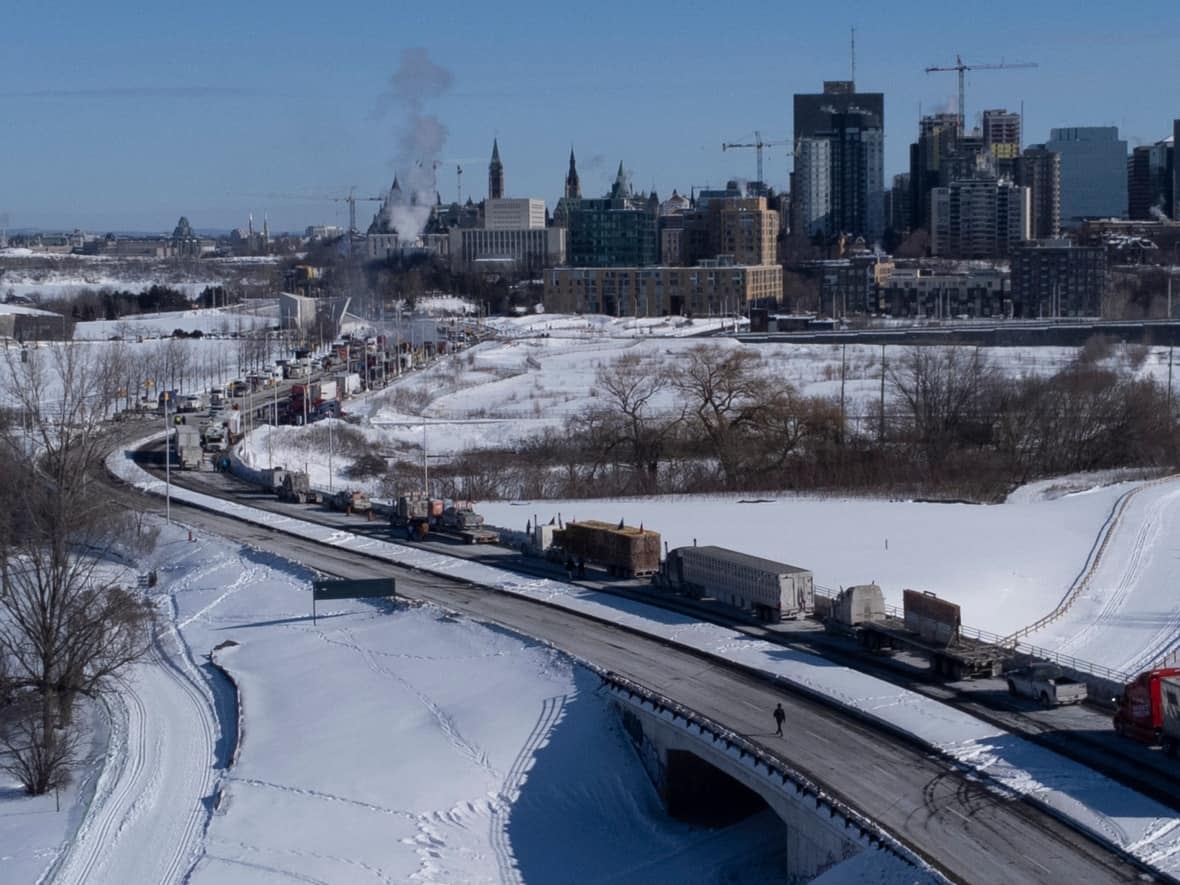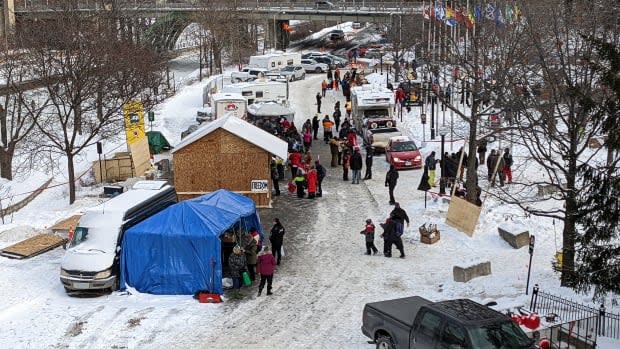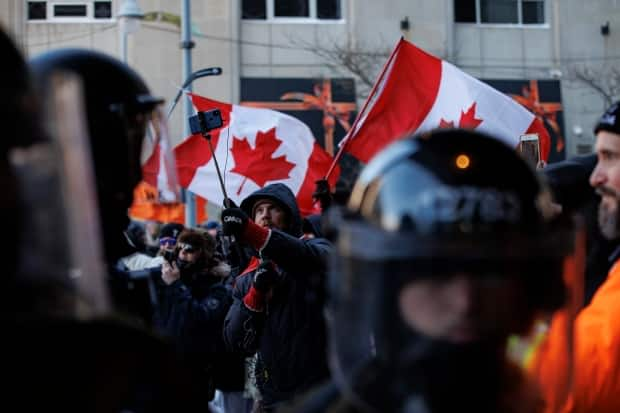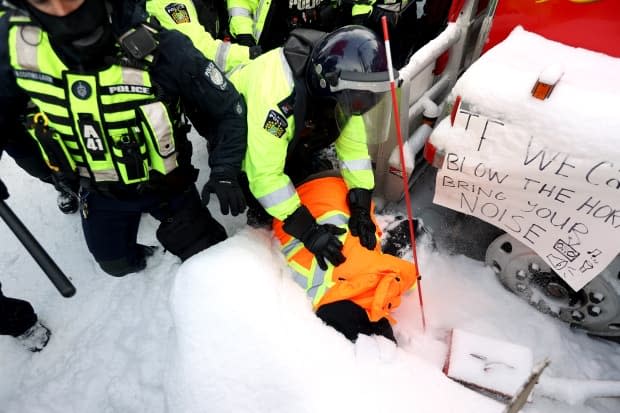Police, NCC emails show communication breakdown during Freedom Convoy

Efforts by law enforcement to monitor and control the large crowds that gathered in downtown Ottawa during the early days of the Freedom Convoy were at times hampered by confusion over jurisdictional power and chaotic communications between officials, according to email records obtained by Radio-Canada.
The 516 pages of exchanges between the Ottawa Police Service (OPS) and the National Capital Commission (NCC), obtained through an access-to-information request, reveal a myriad of plans and concerns flagged by both organizations that were either ignored or missed during critical moments in the weeks before the federal government invoked the Emergencies Act to remove the protesters.
The crucial details include early intelligence from the NCC that convoy protesters could end up staying for months; warnings of "significant danger" to the structural integrity of the Sir John A. Macdonald Parkway (SJAM); concerns over the loss of control over a growing encampment in Confederation Park; and disagreement over law enforcement tactics and operations.
So chaotic was the first weekend that, according to the emails, at one point a person with a broken leg was left waiting on the Rideau Canal Skateway for two hours before an ambulance could arrive.
"Unfortunately there's not much we could do on our end," wrote an NCC conservation officer.
The emails also reveal the NCC's plan to clear an area of illegal structures during the second week of the convoy, only to have it apparently halted by Ottawa police at the last minute.
Frustration over jurisdictional differences appeared to be a recurring theme throughout the exchanges, with the NCC — which oversees some of Ottawa's most iconic landmarks — reaching out to the RCMP for assistance.
Both the NCC and the OPS declined to give interviews, but the City of Ottawa said in a statement to CBC/Radio-Canada that it worked in "lockstep" to support its partners, including the two organizations, during the month-long occupation.
"Obviously, there was this breakdown in communication," said Pierre-Yves Bourduas, a security expert and former deputy commissioner for the RCMP who reviewed the records.
"Ultimately with negotiation, things were moved — but it took quite a few days for it to happen."

'Significant danger' allowing trucks on parkway
According to the email records, officials with the NCC began raising concerns about police's plan to allow the truckers to use the SJAM days before their arrival.
With the city planning to corral protesters towards Kent Street, and with "uncooperative" organizers unlikely to do so, the NCC expressed major concerns about the impact on both the SJAM and the Sir George-Étienne Cartier Parkway (SGEC).
"In short, the infrastructure along both the SJAM & SGEC is not designed to support heavy vehicles and may be significantly damaged if used by this convoy," wrote an NCC official on Jan. 25.
The NCC asked Ottawa police to pass along a message to protesters about the danger of using the two parkways.
"The bridges specifically are not designed to today's standards and are able to support roughly [half] the weight of today's code (32 tonnes vs 65 tonnes)," said the email. "This could be a significant danger if the vehicles travel slowly and/or park on the parkways. Heavy vehicles must not be allowed to use these parkways."
It's unclear what efforts police made to relay the message, but soon the SJAM was clogged with heavy trucks trying to get closer to downtown.
Protesters 'intend to potentially stay for months'
In the days leading up to the Freedom Convoy's arrival in Ottawa, it was also unknown how long protesters intended to stay, but the first report on the protest from the NCC indicates there were signs they could stay long-term.
Two conservation officers were put on shared duty for the entire first weekend to monitor Confederation Park, roughly the size of four city blocks.
On Jan. 28, the first report described the park as "quiet," but the officer noted protesters intended to use it as a food distribution area and overnight hangout spot, using fire barrels for warmth and an elaborate music setup for entertainment.
The officer wrote that protesters "intend to potentially stay for months if necessary." They also spoke with two Ottawa police officers about those observations.
"They were not concerned about the fires and had no intention of intervening," the report reads.
Emails sent that night show the NCC was aware 500 trucks were expected to arrive in Ottawa the following day and that the OPS planned on closing the SJAM immediately.
By Jan. 29, the first Saturday that thousands of protesters descended on the downtown, NCC and city officials were scrambling to erect barriers to Confederation Park.
A week later, the park became a base camp for thousands of protesters, who would eventually build a wooden structure in the middle of it.

Police take 'hands-off approach,' ambulance delayed
A Jan. 29 email from NCC officials gives evidence as to just how chaotic services were during the first weekend of the convoy.
In it, the NCC conceded there was "unfortunately not much we can do on our end" after someone on the Rideau Canal Skateway broke their leg and ended up stuck there for two hours in –20 C temperatures.
At 12:30 that afternoon, NCC officials noted police were taking a "hands-off" approach and predicted that as the afternoon progressed, they would "lose control of the situation."
Over the following days, a flurry of emails show the NCC seeking permission to remove vehicles, while trying to secure barricades and eliminate access to Confederation Park.
It appears any efforts in that vein were too late: in an email sent Feb. 2, six days after protesters arrived, NCC officials formally wrote to the RCMP, asking them to help protect their assets.
Two days later, following warnings protesters would further entrench themselves if not removed, and knowing propane was being stored and structures were being built in the park, the NCC asked for Ottawa police to help get rid of the vehicles.

Confusion over jurisdiction, enforcement action
There was continued confusion over what actions would be taken, however, and who had jurisdiction to act where.
On Feb. 4, the NCC wrote a letter to then-OPS chief Peter Sloly and deputy chief Trish Ferguson, authorizing Ottawa police to enforce trespassing laws in respect to illegal camping and parking on NCC property in Confederation Park.
The letter allowed OPS to remove anyone who refused to cease camping or parking on NCC property, or anyone trying to put up tents there.
In turn, the OPS asked the NCC that day to enforce any regulations in regards to compressed gas and flammables, claiming the city's fire department had advised them they couldn't do that work on federal land.
In response, the NCC told police it was the fire department's job to ensure safety around legal flammables.
Some enforcement action had been planned by the NCC, however. On Feb. 4, Sloly wrote that he had received a text message from an NCC official saying, "All set for shack removal planned for 10h."
What happened next is unclear, but at 2:51 am on Feb. 5, Ottawa police told the NCC that they'd learned a private contractor was set to remove all structures and gas containers in Confederation Park — a plan the force then advised against.
The OPS said any overt action would lead to violence. They said they couldn't get in touch with someone at the NCC after contacting the emergency line.
An NCC official said in a follow-up email there was a "misunderstanding late last night when OPS advised contractors to abort the mission."
It would take nearly two more weeks before police began successfully clearing out the protesters.

NCC, OPS, city decline interviews
Like the NCC and the OPS, the City of Ottawa also declined to be interviewed for this story.
In a statement, Kim Ayotte, the city's general manager of emergency and protective services, said the municipality worked in "lockstep" with the OPS and NCC to "ensure emergency services were maintained and public safety was upheld."
"The City's operations reflected a coordinated effort with the National Capital Region Command Centre (NCRCC), with decisions and actions guided by policing activities," wrote Ayotte.
"The City of Ottawa is currently contributing to a number of reviews regarding the truck demonstration. More information will be released once reviews are concluded."
The NCC said in a statement that Ottawa police were the "law enforcement and traffic management lead — including for NCC roadways in the downtown — for the duration of the Convoy's presence in Ottawa."
The situation downtown was "evolving quickly in the early days," the NCC said, and the commission "worked in lockstep with its partners to help ensure the safety of people on our assets, as well as to secure our assets."
Questions about policing operations were directed to the OPS, who said they would not comment due to the "ongoing parliamentary inquiry into this matter."
The RCMP also declined comment, explaining that the OPS was responsible for handling the protests and has "operational jurisdiction for public order activities taking place in the city of Ottawa."
A public inquiry into the use of the Emergencies Act launched April 25. A federal committee is also reviewing the events surrounding the Freedom Convoy, and there are a number of judicial and internal reviews also underway.
Bourduas said it was obvious from the emails that communications between the NCC and Ottawa police fell apart.
Policing NCC lands being involved in the protests added a layer of complexity for law enforcement agencies, according to Bourduas, because it created confusion over which forces are responsible for what despite the protocol being quite clear.
"There was a gap in enforcement," he said.

 Yahoo Movies
Yahoo Movies 
